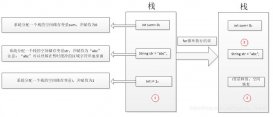将一个实体类所有字段赋值为null
起因
在我们想要使用一个实体类的时候,如果发现创建这个类的时候,给某一些字段设置了初始值(某些场景下的特殊需要),但我们这个时候又不需要这些初始化值的时候,我们就会想要把这些值全部清除掉,让其变为一个干净的类,我们可以手动一个一个去赋null值,我一开始就是这么做的,同事看到后告诉我,你可以尝试使用反射机制,自己封装一个工具类,这样大家都可以使用,于是我就这么做了,也就有了下面比较low B 的代码:
我的代码:
|
1
2
3
4
5
6
7
8
9
10
11
12
13
14
15
16
17
18
19
20
21
22
23
24
25
26
27
28
29
30
31
32
33
34
|
public static void reflectClassValueToNull(Object model) throws Exception { //获取此类的所有父类 List<Class<?>> listSuperClass = Lists.newArrayList(); Class<?> superclass = model.getClass().getSuperclass(); while (superclass != null) { if (superclass.getName().equals("java.lang.Object")) { break; } listSuperClass.add(superclass); superclass = superclass.getSuperclass(); } //遍历处理所有父类的字段 for (Class<?> clazz : listSuperClass) { Field[] fields = clazz.getDeclaredFields(); for (int i = 0; i < fields.length; i++) { String name = fields[i].getName(); Class type = fields[i].getType(); Method method = clazz.getMethod("set" + name.replaceFirst(name.substring(0, 1), name.substring(0, 1).toUpperCase()), type); method.invoke(model, new Object[]{null}); } } //处理此类自己的字段 Field[] fields = model.getClass().getDeclaredFields(); for (int i = 0; i < fields.length; i++) { String name = fields[i].getName(); Class type = fields[i].getType(); //获取属性的set方法 Method method = model.getClass().getMethod("set" + name.replaceFirst(name.substring(0, 1), name.substring(0, 1).toUpperCase()), type); //将值设为null method.invoke(model, new Object[]{null}); } } |
代码写完的那一刻,真的很爽,虽然这个东西比较简单,但还是有一点成就感。然后告诉同事我写好了,让他帮忙优化一下(毕竟他在我心里是一个真正的大牛),午休结束后,他发来了两个方法给我,以不同的方式实现,不过都是基于反射机制。以下是他的代码:
第一种方法
|
1
2
3
4
5
6
7
8
9
10
|
public static <T> T byMethod(T t) { ReflectionUtils.getAllMethods(t.getClass(), method -> Objects.requireNonNull(method).getName().indexOf("set") == 0).forEach(method -> { try { method.invoke(t, new Object[]{null}); } catch (IllegalAccessException | InvocationTargetException e) { throw new RuntimeException(e); } }); return t; } |
第二种方法
|
1
2
3
4
5
6
7
8
9
10
11
|
public static <T> T byField(T t) { ReflectionUtils.getAllFields(t.getClass()).forEach(field -> { try { field.setAccessible(true); field.set(t, null); } catch (IllegalAccessException e) { throw new RuntimeException(e); } }); return t; } |
所以,差距你们看到了吗?反正我看到了!
将实体类中的null属性置为““或者空值
工具类
|
1
2
3
4
5
6
7
8
9
10
11
12
13
14
15
16
17
18
19
20
21
22
23
24
25
26
27
28
29
30
31
32
33
34
35
36
37
38
39
40
41
42
43
44
45
46
47
48
49
50
51
52
53
54
55
56
57
58
59
60
61
62
63
64
65
66
67
68
69
70
71
72
73
74
75
76
77
78
79
80
81
82
83
84
85
|
package com.chryl.util; import java.lang.reflect.Field;import java.lang.reflect.Method; public class ReflectionUtils { /** * 将实体类中的String类型属性为null的置为"" * * @param o * @return */ public static Object nullifyStrings(Object o) { Field[] declaredFields = o.getClass().getDeclaredFields(); for (Field f : declaredFields) { f.setAccessible(true); String name = f.getName(); if ("serialVersionUID".equals(name)) { continue; } //获取属性类型 Class type = f.getType(); try { //只操作String类型 if (type.equals(String.class)) { String value = (String) f.get(o); //如果为空 if (value == null || value.trim().isEmpty()) { //获取属性的set方法 Method method = o.getClass().getMethod("set" + name.replaceFirst(name.substring(0, 1), name.substring(0, 1).toUpperCase()), type);// f.set(o, null); //将值设为空串 method.invoke(o, ""); } } } catch (Exception e) { throw new RuntimeException(e); } } return o; } /** * 含递归 * 将实体类中的 String类型或对象 属性为null的置为""或空对象 * * @param o * @return */ public static Object nullifyObjectOrStrings(Object o) throws ClassNotFoundException { Field[] declaredFields = o.getClass().getDeclaredFields(); for (Field f : declaredFields) { f.setAccessible(true); String name = f.getName(); if ("serialVersionUID".equals(name)) { continue; } //获取属性类型 Class type = f.getType(); try { //获取属性的set方法 String setterMethod = "set" + name.replaceFirst(name.substring(0, 1), name.substring(0, 1).toUpperCase()); Method method = o.getClass().getMethod(setterMethod, type); //只操作String类型 if (type.equals(String.class)) { String value = (String) f.get(o); //如果为空 if (value == null || value.trim().isEmpty()) {// f.set(o, null); //将值设为空串 method.invoke(o, ""); } } else { Class<?> aClass = Class.forName(f.getGenericType().getTypeName()); Object createObj = aClass.newInstance(); //实体赋值 method.invoke(o, createObj); nullifyObjectOrStrings(createObj); } } catch (Exception e) { throw new RuntimeException(e); } } return o; }} |
测试类
|
1
2
3
4
5
6
7
8
9
10
11
12
13
14
15
16
|
package com.chryl.test; import com.chryl.entity.User;import com.chryl.util.ReflectionUtils; /** * Created By Chryl on 2021-08-11. */public class NullStrTest { public static void main(String[] args) throws Exception { User user = new User(); User user1 = (User) ReflectionUtils.nullifyStrings(user); System.out.println(user1); User user12 = (User) ReflectionUtils.nullifyObjectOrStrings(user); System.out.println(user12); } } |
先创建需要的实体
|
1
2
3
4
5
6
7
8
9
10
11
12
13
14
15
16
17
18
19
20
21
22
23
24
25
26
27
28
29
30
31
32
33
34
35
36
37
38
39
40
41
42
43
44
45
46
47
48
49
50
51
52
53
54
55
56
57
58
59
60
61
62
63
|
package com.chryl.entity; import java.io.Serializable; /** * Created By Chryl on 2021-08-11. */public class User implements Serializable { private static final long serialVersionUID = 930878416859194735L; private String username; private String password; private String age; private ParamsList paramsList; public User() { } public User(String username, String password, String age) { this.username = username; this.password = password; this.age = age; } public User(String username, String password, String age, ParamsList paramsList) { this.username = username; this.password = password; this.age = age; this.paramsList = paramsList; } public static long getSerialVersionUID() { return serialVersionUID; } public String getUsername() { return username; } public void setUsername(String username) { this.username = username; } public String getPassword() { return password; } public void setPassword(String password) { this.password = password; } public String getAge() { return age; } public void setAge(String age) { this.age = age; } public ParamsList getParamsList() { return paramsList; } public void setParamsList(ParamsList paramsList) { this.paramsList = paramsList; }} |
|
1
2
3
4
5
6
7
8
9
10
11
12
13
14
15
16
17
18
19
20
21
22
23
24
25
26
27
28
29
30
31
32
33
34
35
36
37
38
39
40
41
42
43
44
45
46
47
48
49
50
51
|
package com.chryl.entity; /** * Created By Chryl on 2021-08-12. */public class ParamsList { private String param1; private String param2; private String param3; private String param4; public ParamsList() { } public ParamsList(String param1, String param2, String param3, String param4) { this.param1 = param1; this.param2 = param2; this.param3 = param3; this.param4 = param4; } public String getParam1() { return param1; } public void setParam1(String param1) { this.param1 = param1; } public String getParam2() { return param2; } public void setParam2(String param2) { this.param2 = param2; } public String getParam3() { return param3; } public void setParam3(String param3) { this.param3 = param3; } public String getParam4() { return param4; } public void setParam4(String param4) { this.param4 = param4; }} |
以上为个人经验,希望能给大家一个参考,也希望大家多多支持服务器之家。
原文链接:https://segmentfault.com/a/1190000012707351















